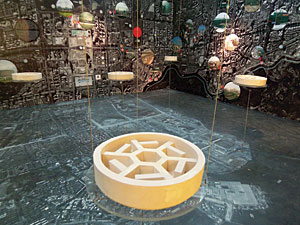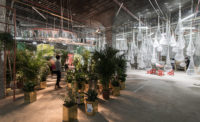2007 Shenzhen-Hong Kong Bi-City Biennale of Architecture and Urbanism.
Curated by Qingyun Ma (Shenzhen, through March 9) and Weijen Wang (Hong Kong, through March 15).
Can we envision a city with buildings that don’t last forever? Should buildings have expiration dates? Can we trust our judgment about the future? These are the issues being debated at the 2007 Shenzhen-Hong Kong Bi-City Biennale of Architecture and Urbanism. The biennale features more than 130 exhibits. At least 200 architects, urban planners, and artists have converged to brainstorm about some of the most pressing issues facing the future of the city. The theme, “The City of Expiration and Regeneration,” is a fitting one to take place in the fastest-urbanizing country in the world.

Shenzhen, a special economic zone in the forefront of China’s modernization, is experiencing urban growing pains. In just 30 years, this hamlet has mushroomed into a city of 10 million. For architects and planners who practice here and elsewhere in China, the 2007 biennale presents a golden opportunity to explore issues that every city faces, regardless of its pace of development. At the exhibition opening in Shenzhen, a series of “guerrilla forums” were held to discuss a range of topics, from green architecture practice to urban-space use.
“We considered certain regional concerns and different approaches to the future of the city, ranging from participative art events to government-sponsored campaigns,” says chief cocurator Qingyun Ma, a Shanghai architect and dean of the School of Architecture at the University of Southern California. “And there was an effort to promote young and unknown architects and thinkers in China.”
Certainly, some of the Shenzhen exhibits are thought- provoking, but many do not seem to live up to what they promised. A few even appear amateurish. To be sure, the biennale broke the text-and-model mold that so often dominates architecture exhibitions. By employing a variety of media, from ambient sounds and music to special lighting and video projections, the exhibition is at once dazzling—and dizzying. At one of the Shenzhen venues, visitors are greeted with a cacophony of sounds booming from several of the exhibits.
The installations with the most substance are among the simplest. Not coincidentally, they are representations of built projects, not academic exercises that will expire when the show closes.
For example, the Shenzhen-based firm Urbanus presented a working-class housing complex in nearby Nanhai. The circular, slab-housing design represents a regeneration of the traditional housing type, tulou (“mud mansion” in Chinese), which is unique to a tribe in southern China. In this modern rendition by Urbanus, the traditional form is being adapted to an urban infill site and will incorporate residential, commercial, and social uses under the same roof. In the exhibit, viewers are encouraged to suggest sites in Shenzhen where a modern tulou might fit, as the firm is actively scouting for sites in the city.
Two winning entries from Austrian firm rpaX and Dutch firm MVRDV for a competition to develop a new town in Shenzhen also offer architects’ insights about balancing privacy and density in shaping the next generation of urbanism. The presentations are mounted on windows and are illuminated by sunlight pouring in from outside. Even without benefit of electric light, the potential excitement of this newly planned Radiant City nonetheless comes through.
However, in Hong Kong, the story of urbanization is vastly different, although the two Chinese cities are only separated by a river. A century and a half in the making, this former British colony is just now looking back in time, peeling away the layers of fabric in search of heritage sites. As a matter of fact, the choice of Hong Kong as one of the two venues is tied to the theme of understanding the urban fabric.
Some of the best exhibits in this venue focus on much older cities, such as Beijing and Tokyo.
In REaD Beijing, two Tsinghua University architecture professors tell the story of the urban transformation of Beijing in clear and clever graphics. They label the city wall and gates as the effaced edifices that have since lost out to the new industrial icon—the smokestack. They trace the history of the “building banquet” of the 1980s that has produced current landmarks, such as the National Library and the Great Wall Hotel, to the next wave of landmarks, the Rem Koolhaas–designed CCTV headquarters and the National Stadium (“Bird’s Nest”) by Herzog & de Meuron for the 2008 Summer Olympics.
The Hong Kong venue, a recently mothballed historic police station and prison complex, is among the best-preserved sites in the city. While the constricted office and cells may not lend themselves to fantastic exhibition spaces, crisscrossing the labyrinthine complex to view different exhibits is an experience. The complex is shoehorned on steep hills among high-rises in the city’s throbbing center. On the way out of the venue to the main street, well-worn concrete steps lead one through a smorgasbord of vendors and traditional markets. That gives one a much better understanding of the city’s fabric than any exhibition can.



Post a comment to this article
Report Abusive Comment